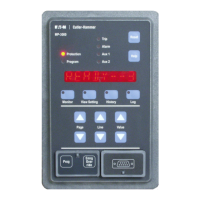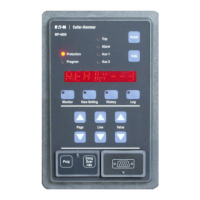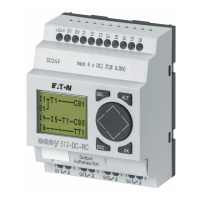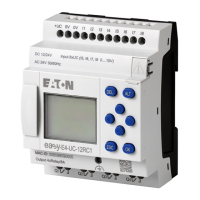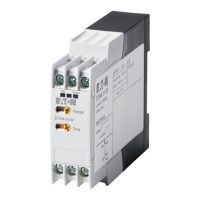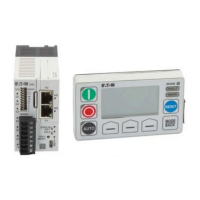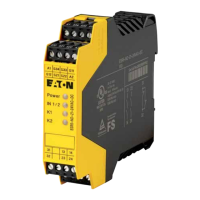For more information visit: www.cutler-hammer.eaton.com
Page 5-7
Effective 10/02 IL17562BH04
(STOP XX, P1L9) setting. Remember that the Stop Current Threshold
is programmed as a percentage of PCT. To convert this setting to be a
percentage of FLA, multiply the Stop Current Threshold by PCT/FLA.
5.5.6 Setting P5L6, Motor Start Transition Timeout (TRNT)
Sets the maximum duration of the START state of the motor before
transition to RUN. See P5L7 for further explanation.
5.5.7 Setting P5L7, Transition on Event (TRN TIME, TRN I,
TRN T+C, or TRN T/C)
This setting is used with P5L5 and P5L6 to determine what events
must happen for the MP-3000 to declare a transition from START to
RUN. Select one of four choices:
TRN TIME—Transition to RUN after time setting (P5L6) only. Ignore
current.
TRN I—Transition when starting current drops below setting (P5L5)
only. If the time set in TRNT P5L6 expires before the current transition,
trip the motor.
TRN T+C—Transition on time or current, whichever comes first.
TRN T/C—Transition on time and current. Both must occur, and the
current must drop below the setting before the time delay expires. If
the timer expires before the current falls below the set transition level,
trip the motor.
In addition, the MP-3000 provides a transition control signal to a
reduced-voltage starter, allowing it to raise the voltage to the running
value. To do this, the transition function activates the contact output
AUX2 (unless the function of AUX2 has been redefined by setting
changes in the AUX2 configuration settings page, Page 10).
NOTE
EVEN IF THE TRANSITION CONTROL OUTPUT IS NOT USED, SET
THE TRANSITION FUNCTION TO PROVIDE CLEAR INDICATIONS
OF THE ACTUAL STATE OF THE MOTOR (START; RUN) ON THE
FRONT-PANEL DISPLAY AND VIA DATA COMMUNICATIONS. A
GOOD WAY TO DO THIS IS TO USE THE SETTINGS OF P5L7 = TRN
T+C AND P5L5 = 130% OF FLA. MODIFY THE LATTER, IF NEEDED,
TO LIE AT A TRANSITION VALUE BETWEEN THE STARTING
CURRENT AND POST-START MAXIMUM LOAD CURRENT.
5.5.8 Setting P5L8, Incomplete Sequence Report Back Time (INSQ)
Sets the required process report-back time in seconds. This function
can be set to OFF.
The incomplete-sequence function requires a report-back contact
from the process which the motor runs—any indication that the
process has proceeded to operate as expected some time after the
motor start. If the process doesn’t start up correctly, the contact
doesn’t close within the expected time. If a problem develops later on,
the report-back contact opens. In either case, the open contact state
indicates that the motor should be tripped.
To use this function, set a time limit for report-back here. Set P5L9,
next, to define the start of report-back timing. Connect the report-
back contact to MP-3000 Discrete Input 2. This input must then be
energized before the set time expires, or the relay trips for incomplete
sequence.
Note that the input must be energized continuously after the time
delay has expired to hold off this trip.
Note that Discrete Input 2 setting P7L1 below is automatically
assigned to the function INC SEQ if a time delay is set here. All other
alternate uses for Discrete Input 2 (P7L1) are suppressed and not
visible until INSQ is set to OFF.
5.5.9 Setting P5L9, Incomplete Sequence Start Timer Event
(INSQ TRN or INSQ ST)
Choose either to start the incomplete-sequence timer when the motor
start is declared (INSQ ST), or when the transition from start to run is
declared (INSQ TRN).
5.5.10 Setting P5L10, Long Acceleration Time (LAT)
Sets a time interval during which the motor is permitted to accelerate
a high-inertia load, which is longer than the locked-rotor time. This
function can be set to OFF, and usually should be. If the thermal-
model accumulator bucket fills to 100% during the long acceleration
time, it is limited to that value and the thermal trip is held off until the
LAT delay expires. By then, the thermal bucket level must have
decreased (thermal model cooled) below 100% or the motor trips.
The LAT function should be used only on motors with a zero-speed
switch (normally-closed contact which opens when the motor actually
begins to spin). Connect the zero-speed switch contact to MP-3000
Discrete Input 1. The Zero-Speed Switch function must be enabled
(ZSW ON)- see setting P5L11 below. The MP-3000 then requires the
zero-speed switch to open within LRT/2 (half of locked-rotor time
setting P1L3) after a start, or the motor is tripped by the ZSW function.
This protects a completely stalled motor from being damaged when
the LAT timer blocks the locked-rotor thermal trip.
CAUTION
THE LONG ACCELERATION TIME (LAT) FUNCTION IS CAPABLE
OF BLOCKING THE CRITICAL LRC-LRT ROTOR THERMAL
PROTECTION DURING A START AND DESTROYING THE MOTOR.
TURN LAT OFF UNLESS ABSOLUTELY NEEDED, AND MOTOR
SUITABILITY FOR THIS STARTING DUTY HAS BEEN CONFIRMED.
USE ONLY WITH ZERO-SPEED SWITCH FUNCTION ZSW ON AND
SWITCH INPUT CONNECTED, TO PROTECT A STALLED MOTOR.
5.5.11 Setting P5L11, Zero Speed Switch On or Off (ZSW ON
or ZSW OFF)
Enables the function which checks to see if the motor begins to
physically spin after a start. Requires a zero-speed switch on the motor
which is closed at rest, and opens as the rotor begins to turn. Connect
the zero-speed switch contact to MP-3000 Discrete Input 1. If the contact
fails to open within LRT/2 (one half of locked-rotor time setting P1L3) after
a start, the relay trips with a zero-speed switch trip message.
This protection is always useful, but is essential if the Long Accelera-
tion Time (LAT) function set by P5L10 is used.
Note that if the ZSW function is set to ON, then Discrete Input 1 is
automatically configured to be the zero speed switch input. All other
alternate function settings for Discrete Input 1 (P6L1) are suppressed
and not visible until ZSW is set to OFF.
With ZSW ON, the MP-3000 checks Discrete Input 1 for voltage at the
very moment it sees a start—it wants to see the initially closed zero-
speed switch, which opens shortly thereafter as the motor spins. If it
fails to find the closed contact, it trips immediately with a zero-speed
switch trip message. Check the wiring and contact for problems.

